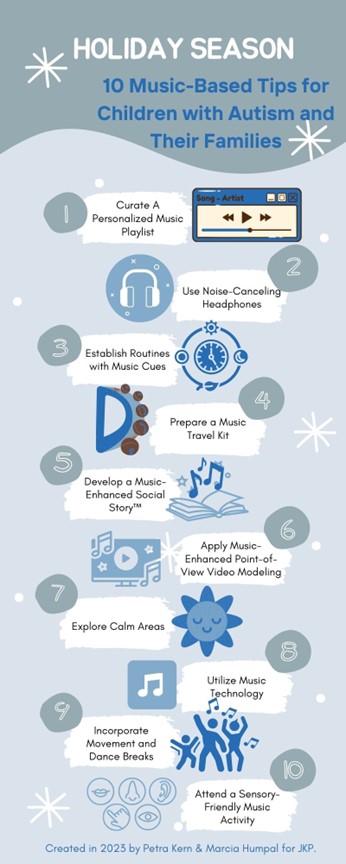The holiday season is filled with get-togethers, festive events, and treasured family traditions! Yet, children with autism and their families, may face unique challenges as holiday travel, unfamiliar environments, sensory overload, and changing routines may disrupt the joy of the season.
In this blog post, we will provide practical tips for planning ahead and using music-based strategies to make the holiday season easier and enjoyable for all. There’s also a helpful infographic at the end to download for sharing or future use! For further information, check out our book Early Childhood Music Therapy and Autism Spectrum Disorder, Second Edition.
- Curate a Personalized Playlist: Involve your child in creating a tailored playlist with preferred relaxing music. Include songs to hum along and calming tunes to create a serene environment during the journey or event. Familiar tunes may lift your child’s spirit and provide predictability and comfort in unfamiliar surroundings.
- Use Noise-Cancelling Headphones: Acquire child-size noise-cancelling headphones to muffle loud noises and sudden, unexpected sounds often experienced on airplanes or in crowded spaces. By reducing volume and unpleasant sounds, headphones supply a sense of control and thus reduce overstimulation that may lead to anxiety.
- Establish Routines with Music Cues: Embed transition songs into upcoming routines. Insert different words to familiar songs to prompt your child through unfamiliar situations like going through security, boarding the plane, waiting in line, or using a unfamiliar restroom. This can help establish a sense of structure and predictability during a trip or in an unaccustomed encounter. (Chapters 6, 13)
- Prepare a Music Travel Kit: Put together a kit with music-based items. Include small musical instruments such as shakers, singable books as well as props like scarves, blankets, and puppets. This customized kit can help engage and comfort your child during a long trip or in overwhelming situations. (Chapter 9)
- Develop a Music-Enhanced Social Story™: Build a basic Social Story for an anticipated social situation your child may encounter. Set the Social Story to music and practice the behavior expectation with your child. Social Stories can offer a reference point for your child; putting it to music can aid in memory and recall of the appropriate response. (Chapters 5, 7, 10)
- Apply Music-Enhanced Point-of-View Video Modeling: Capture a 2-3-minute video clip of a specific discrete skill such as setting a festive table for your family meal. Watch the video with your child serval times and just before the task. Adding festive music to the video clip can function as a positive reinforcer and support your child’s task completion. (Chapter 5, 7, 10)
- Explore Calm Areas: Find a sensory-friendly room or quiet area at the airport, on the road, or venue. Low volume and minimal sound, moderate levels of lights, and a calm atmosphere are ideal. Adding soft instrumental or nature sounds can support your child’s self-regulation when the level of arousal is high. (Chapter 10, 13)
- Utilize Music Technology: Use technology to your advantage. Add your child’s favorite music videos or apps to their smartphone or tablet. They can serve as a familiar, comforting, and enjoyable distraction, but also as a shared activity with family members or friends. (Chapters 6, 13)
- Incorporate Movement and Dance Breaks: Engage your child in movement and dance during travel stops or to move to another location to get away from a crowd. Bring along favorite movement songs or upbeat music! Movement to music can serve as a powerful tool for self-regulation and can help release energy. (Chapter 12)
- Attend a Sensory-Friendly Music Activity: Take your family to a community outing such as a sensory-friendly holiday concert. Get a sensory map of the venue, inquire about alternate spaces for taking breaks if needed and policies about making noise or walking around; prepare your child with pre-made videos, picture schedules, or books about the intensity of the sensory experiences. Sensory-friendly environments may allow your child and anyone who is neurodivergent to manage sensations successfully and fully experience the joy of festive music. (Chapter 10)
As you navigate the holiday season, consider the power of music in fostering a sense of calm and joy for your child and family. By personalizing playlists, using noise-cancelling headphones, establishing routines, preparing a music kit, making musical social stories, employing videos with music modeling useful skills, exploring calm area spaces, utilizing technology, engaging in movement to music, and perhaps exploring opportunities for attending sensory-friendly concerts, families can prepare for and facilitate holiday experiences that create fond family memories for all.

This post was written by JKP authors Dr. Petra Kern and Marcia Humpal.
Dr. Petra Kern and Marcia Humpal are board-certified music therapists with jointly 70+ years in clinical practice, research, education, and organizational leadership. Known for their editorial and innovative work with young children and families, they published a landmark book with JKP on early childhood music therapy and autism spectrum. This blog offers evidence-based tips and refers to the book’s chapters for more information.
Kern, P., & Humpal, M. (Eds.) (2019). Early childhood music therapy and autism spectrum disorder: Supporting young children and their families (2nd edition). Jessica Kingsley Publishers.